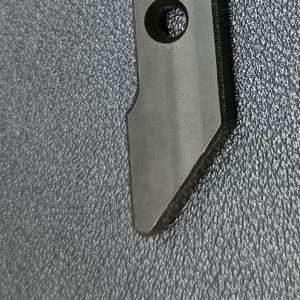MATERIALS
Polyethylene (PE)
Polyethylene is known for its malleable properties. It offers a high strength-to-weight ratio, impact strength, chemical inertness, temperature, and weather resistance.

Polyethylene (PE) At a Glance
| Process compatibility | Applications | Subtypes | Tolerances | Wall Thickness | Max Part Size | Strengths | Lead Time | Price |
| CNC Mill CNC Lathe | Accurate products for food processing, pharmaceuticals, packaging, agricultural products, cables, pipes, and fitting. | UHMW-PE HDPE | Not lower than ±0.125mm (±0.005″) based on the drawing ( ISO 2768) | Minimum 0.80 mm (0.03″), but this can change depending on the proportion of the wall thickness to the linear dimension. | 200 x 80 x 100 cm | Relatively mechanical low strength and hardness, but excellent impact strength. | Minimum 3 days. Not more than 10 days; for all complex parts. | $$ |
Introduction to Polyethylene (PE)
Polyethylene (PE) is an engineering thermoplastic, which offers relatively mechanical low strength and hardness but excellent impact strength. Polyethylene also has two types of options High density and low density.It is known for its malleable properties. It has a high temperature, oil, steam resistance, and electrical insulation.
All these properties make Polyethylene a versatile engineering material, the best choice in food processing, pharmaceuticals, packaging, agricultural products, cables, pipes, fitting, and many more applications.
Precision CNC Machining for Polyethylene (PE)

- Quality CNC Machining for PE Materials: Our commitment to excellence is evident in our rigorous quality control measures, ensuring that each polyethylene component meets the desired specifications.
- Custom PE Machining Services: We adapt our precision machining processes to suit the unique requirements of your projects, ensuring that each component reflects the highest standards of quality.
Cost-Effective Precision at Prolean
By choosing us as your PE CNC Machining service company, you leverage our extensive experience in CNC Machining of Polyethylene Components. PE CNC machining services are about meeting and exceeding your expectations with each component we craft.
- Competitive Pricing: Receive a transparent and upfront PE CNC Machining Price that ensures value without the surprise of hidden costs.
- Quality Assurance in PE CNC Machining: Even with our competitive pricing, the quality is never compromised, reflecting our Top Polyethylene Machining Expertise.
Online PE CNC Machining Service Provider: We merge Precision PE CNC Machining Techniques with the convenience of modern technology. With us, you gain access to Fast PE CNC Machining Services that are just a few clicks away, backed by a commitment to precision, affordability, and quality that sets industry benchmarks.
Expert PE Machining Solutions for High-Quality Components
At Prolean, Our approach to the CNC Machining of Polyethylene Components is not just about precision; it’s about redefining the industry’s quality and efficiency standards. We execute the CNC Machining of Polyethylene Components with the utmost precision using advanced techniques and CNC machinery. Our engineers and machinists bring a level of skill and knowledge to PE CNC Machining that is unmatched. We also provide custom solutions tailored to each project’s intricacies.
With Prolean, you are assured of:
- Advanced PE CNC Machining Techniques: Utilizing the latest technology and methods to ensure the highest quality of machined components.
- Efficiency and Performance: Prolean PE CNC machining services are designed to optimize every aspect of the production process, from the initial concept to the final product.
- Bespoke Machining Solutions: Every project is different. That’s why our services are specifically tailored to meet the unique requirements of your polyethylene components.
- Fast and Reliable Delivery: Time is often of the essence. We provide a Fast PE CNC Machining Service that ensures your components are manufactured and delivered promptly.
- Cost-Effective Services: Prolean is committed to offering Cost-effective PE CNC Machining Solutions. We believe in providing value without hidden costs maintaining transparency with our clients.
Try Prolean Now!
Global PE CNC Machining Services with Instant Online Quotes
Our Global PE CNC Machining Services are transforming how industries access precision engineering. The convergence of technology and craftsmanship allows us to offer Instant Quotes for PE CNC Machining Services, ensuring that wherever you are in the world, our services are within reach.
The platform is designed to be intuitive, guiding clients through a hassle-free process that culminates in Cost-effective PE CNC Machining Solutions. It embodies our commitment to providing Transparent and Competitive PE CNC Machining Prices. This approach demystifies the cost structure, allowing for precise budgeting and financial planning for projects of any size. Moreover, we pride ourselves on being The Biggest PE CNC Machining Quoting Service.
Our capability to manage large volume orders seamlessly aligns with our promise to deliver Fast PE CNC Machining Services. This promise is underpinned by a robust infrastructure equipped to handle the intricacies of polyethylene machining. Our commitment to Quality Assurance in PE CNC Machining. Whether the order is small or large, our quality checks are stringent and uncompromising.
Online Convenience and Global Reach
In the spirit of providing comprehensive solutions, Prolean also emphasizes Cost-effective PE CNC Machining Solutions. We understand the importance of balancing budget with performance, and our pricing structure is designed to be competitive while maintaining exceptional quality standards.
- Fast and Easy Quotes: Our online system is engineered to provide quick PE CNC Machining quotes, streamlining the path from inquiry to production.
- Global PE CNC Machining Services: With a digital reach that spans continents, we bring Expert PE Machining Solutions to clients worldwide, ensuring that no matter where you are, quality machining is just a click away.
Our platform’s sophistication lies in its ability to provide instant access to these services, simplifying the process of obtaining Instant Quotes for PE CNC Machining Services. This service is designed for both speed and convenience, aligning with the needs of a diverse global clientele.
Get Your Parts Made Today
All uploads are secure and confidential.


